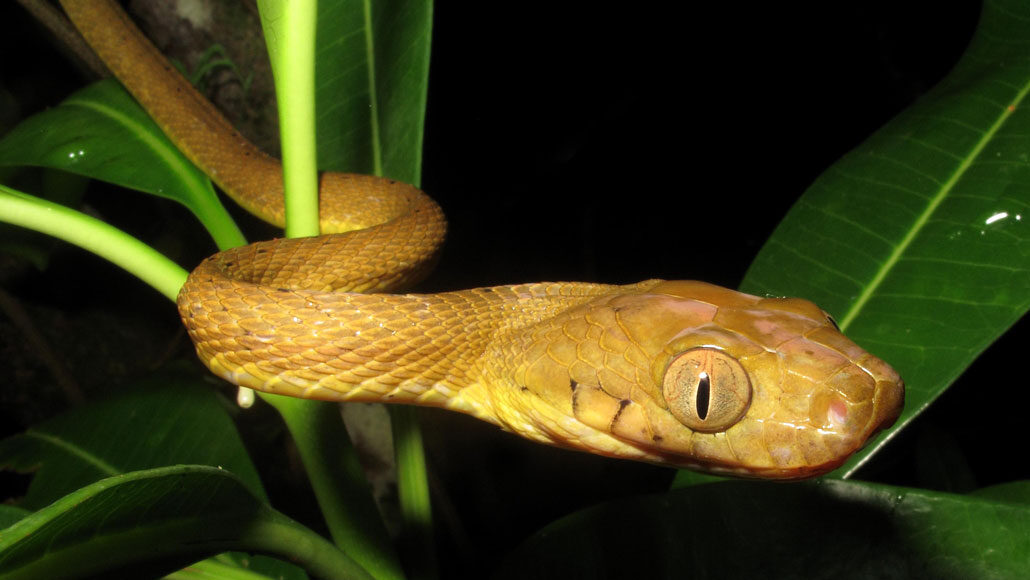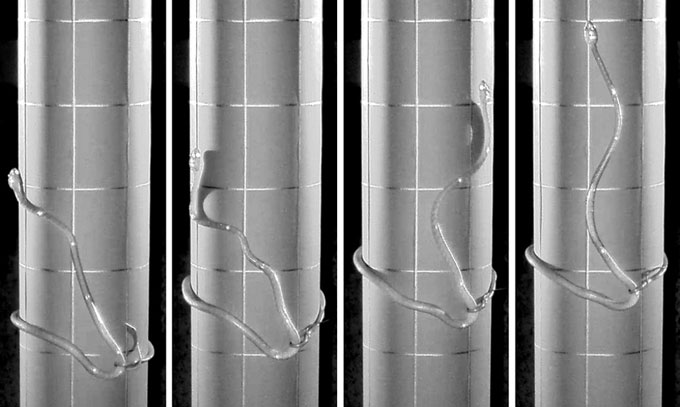Newfound technique allows some tree snakes to climb wide trees
Brown tree snakes use a lasso-like tail loop to wriggle up wide trees

When a tree or pole is wide, brown tree snakes use their tails as a lasso to climb them.
Bjorn Lardner
Snakes do a lot more than slither. Some swim, while others sidewind across sand. Some snakes even fly. The brown tree snake has a brand-new trick for climbing trees. It wraps its tail around a tree or pole in a lasso-like grip. Then it wriggles to propel itself up. It isn’t easy for the snakes. But it works. And this looping trick lets these snakes slowly make it up structures that would otherwise be too wide to climb.
Brown tree snakes (Boiga irregularis) are a problem in Guam, an island that is a U.S. territory in the Pacific Ocean. The snakes are invasive, meaning they are not native to Guam. They were brought by people. The reptiles are infamous for having gobbled up almost all of island’s native forest birds. (As of late last year, they were also spotted on the nearby Cocos Island, suggesting this tiny atoll’s animals may be at risk, too.) The big snakes can even climb up utility poles and across power lines. At times in the 1990s, these snakes caused one electrical outage once every four days or so. Understanding all the ways brown tree snakes get around could help scientists better control them.
And the newfound lasso technique is a surprise.
Julie Savidge is an ecologist. She works at Colorado State University in Ft. Collins. Savidge was part of a team investigating ways to keep these tree-climbing snakes away from Micronesian starlings. The birds are one of only two native forest birds left on Guam.
One of the scientists’ tests was whether a wide pipe — called a baffle — around a pole would keep the predators from reaching a starling nest box at the top. The researchers watched hours of video footage to see how well the baffle deterred the brown tree snakes. Then they saw one snake do something unexpected. It lassoed itself around the baffle and began slowly ascending.
“We were in total shock,” says study coauthor Thomas Seibert. He is also an ecologist at Colorado State. “This isn’t something that a snake is supposed to do.”
Loop de loop
If a tree has rough bark, snakes will often slither straight up. But if the tree is too smooth, brown tree snakes and other snakes typically coil around the trunk multiple times. A snake wraps the front of its body around the trunk. Then it coils its back end around the tree in another loop to get a second grip. The snake then stretches its neck up and repeats the process. In this way, it inches upward.
But if a snake has to wrap around a tree multiple times, it can only climb thin trees. The snake won’t be long enough to wrap itself around a wide tree twice. But the lasso climbing method gets around this problem. Here, a snake loops around a tree just once. It then hooks its tail around its body to get a tight grip on the tree. Now, it wriggles that lasso-like grip to climb. That allows the snake to climb wide trees, explains Bruce Jayne. He is a biologist at the University of Cincinnati in Ohio.
In later lab experiments, the researchers placed brown tree snakes inside an enclosure with a wide pole. A dead mouse topped the pole, serving as bait. To get the tempting snack, several brown tree snakes used the lasso-like move. But the method is not efficient. Five brown tree snakes, ranging from about 1.1 to 1.7 meters (3.6 to 5.5 feet) long, climbed less than a millimeter (0.04 inch) per second, on average.
This was exhausting for the snakes, Seibert says. “You could see them breathing heavily, and they’d take frequent breaks.” As a result, the snakes probably use the lasso-like motion only when they encounter trees or poles too wide and smooth to be climbed any other way.
The scientists reported the brown tree snakes’ lasso climbing method January 11 in the journal Current Biology.

Snake moves could lead to better robots
It’s “kind of whacky” to see a snake move like this, says Gregory Byrnes. He’s a biologist at Siena College in Loudonville, N.Y. Byrnes was not involved in the work. He is not entirely surprised that brown tree snakes have devised a way to deal with wide trees or baffles. These snakes are very agile climbers. They can bridge large gaps. They slide up steep surfaces. They also move across thin wires. “They have so much control over their bodies that if they’re given a challenge … they figure out a way to [overcome] it,” he says.
Testing brown tree snake skills could help design better baffles or other tools to protect endangered birds on Guam, Savidge says. The scientists have already placed bird boxes on even wider poles — poles so wide a snake can’t even form a lasso. “The birds adopted these birdhouses and have done very, very well,” she says.
Better understanding snakes’ bag of climbing tricks could also help scientists build better robots, says Henry Astley. He’s a biologist at the University of Akron in Ohio who was not involved in the work.
Astley and others are interested in building snakelike robots to navigate where wheeled or legged robots can’t go. He envisions snake bots slithering through earthquake rubble to search for survivors. They could also wriggle inside large machinery to perform inspections. Discovering a new way that a snake moves could help engineers make better use of serpentine machines.







